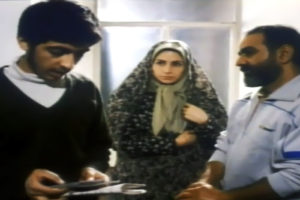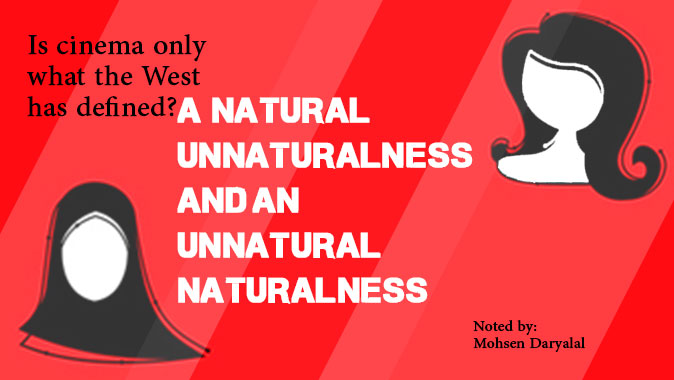In order to answer this question hours-long debates should be held, several experts’ opinions should be asked and based on them a new definition and framework should be provided but for the sake of the present discussion, we can touch one of the subtopics: "women".
Noted by: Mohsen Daryalal
TEHRAN (AIPFF) – Cinema, or what is referred to as cinema, has become synonymous with attracting audiences by any means. Out of the 36 methods which are taught in western books to cause suspense in stories, about 20 are about sexual issues which pivot around women. This is the West’s cinema, or it is better to say, this is the cinema the West has created and defined. Now the question is, “Is cinema only what the West has defined?”
In order to answer this question hours-long debates should be held, several experts’ opinions should be asked and based on them a new definition and framework should be provided but for the sake of the present discussion, we can touch one of the subtopics: “women”. If we consider the topic of women the major difference between Islamic ideology and the West’s ideology, then it seems that the first issue which should be dealt with is the way women are represented and the way they dress in movies in cinema and television. A topic which, compared to any other topic, has attracted more attention and due to its wide appeal and also in order to reflect life’s reality in movies has no choice but to invade peoples’ privacy. On the surface, there are many contradictions. For example, in the house and in the presence of family members, women dress more causally than when they are outdoors and within society, and in order for things to look natural and to be close to reality, cinema seeks to present everything the way it happens. Therefore, it insists on showing sexual relationships, love makings, mothers’ affection toward their sons, and all that jazz. Besides, in order to show everything more naturally the way women dress inside their houses should be different from and certainly more causal than the way they dress outside of their houses, and cinema does not shrink from showing it. But concerning this issue there is confrontation between two groups: those offstage and the audience. Assuming that all those offstage are or have become Mahram (not considered strangers according to Islamic Sharia) to each other, how should we deal with the mass audience? What will be the effect of showing and seeing these scenes on the audience? And these kinds of questions which will probably remain unanswered.
The problem is the nature of showing these things. The problem is the inherent contradiction between this point of view and function and Islamic ideology. In Islamic ideology, there is a lot of emphasis on the one hand on hiding beauty and on the other hand on disregarding (closing one’s eyes to beauty), while cinema within the framework of the West insists on the contrary. On the one hand, it places emphasis on showing everything and on the other hand, it insists on the audience to watch those things and to be absorbed in them. This is the apparent contradiction between the West and Islam with regard to cinema.
Cinema based on the Islamic principles
But can one define an Islamic cinema based on the Islamic principles? That is, concerning the issue in hand, i.e. the way women dress in movies, what can one do in order both for the productions to be attractive and for the Islamic rules and principles to be observed? How can one transcend limitations imposed within the framework of cinema in a way that the audience does not find the movie unnatural? How can one portray a couple’s love for each other without their hugging each other at a time of great sorrow? How can a loving mother who cannot kiss her son show how much she loves him?
The first problem we face is the unnaturalness of relationships- that is a mother who cannot hug and kiss her son may not be able to show her affection, a couple who cannot express their love for each other, etc. And certainly wearing hijab in the presence of one’s husband at home is very unnatural.
These are questions which cross one’s mind; one asks oneself how is it possible to portray natural life without depicting these things?
But that is not the problem. The problem is that we are used to seeing such things in order to consider relationships as natural. We cannot feel naturalness unless we see these kinds of relationships, and this is just getting used to seeing them. How often, in everyday life, do we see a mother who lovingly hugs her grown-up son and kisses him? Or how often do we see romantic relationships between couples? Hardly ever, because we are not allowed in peoples’ privacy but everything is natural, even more natural than it is presented in movies. However, our definition and perception of being natural have changed. In order to enter all areas, modernism makes up excuses and considers them so normal that the audience agrees with it and thinks supposing that two people are mother and son we should see them hugging each other or we should see that upon entering her house, a woman immediately takes her clothes off. But we have forgotten that all these are subsidiary issues and if a story is real and natural the audience will not notice the way women have dressed, and even does not like to see these kinds of relationships which are of secondary importance and the content and the theme will be more important for him than relationships.
Now, in lieu of the first question one should ask why it is necessary to show relationships and clothes the way the audience does not see in real life. Isn’t it unnatural? Isn’t it unnatural that a young couple makes love before the camera and other people? Isn’t it unnatural that people’s privacy, relationships, and the way they dress are revealed to others? Are these still considered private? Which one is more unnatural: showing these relationships and the way people dress or not showing them?
Iran’s cinema; An experience of Islamic cinema
Successful models can be very helpful for questions which come into mind. After the Islamic Republic of Iran, a major shift took place in Iranians’ way of thinking and those in charge began to look for Islamic approaches to everything. Cinema was one of those areas. A new place was created for women in movies and cinema, objectifying them in movies which had its roots in the western culture came to an end, and an appropriate and valuable position was given to them. In “The Glass Agency” directed by Ebrahim Hatamikia, although the part of Haj Kazem’s wife, Fateme, seemed unimportant, compared to Hai Kazem’s part, it was imprinted more on the audiences’ memory and this was only because of her mysterious character and hijab. The same thing is true about the part of Leili in “Leili is With Me” directed by Kamal Tabrizi. Another example is Aunt Leila in “Once Upon a Time” whose part was played by Zhaleh Olov, who compared to the above examples played a more key role, and despite wearing hijab and observing Islamic rules impressed the audience significantly. One can also refer to more recent productions. In movies such as “The Third Day” directed by Hossein Latifi the brother-sister relationship has been portrayed so beautifully and all the emotions have been expressed in a way that the audience does not feel, even for a moment, that the actors are playing a movie. At the same time, all relationships are within the framework of Islam and the way the actress (Baran Kosari) has dressed, while observing Islamic dress code is totally natural. There are so many similar examples which have evolved over time.

Haj Kazem and his wife in the film “The Glass Agency” directed by Ebrahim Hatamikia
In this thinking framework women are no longer considered stimulants to buy more productions and to tempt the audience to watch movies. Removing all private relationships and inappropriate clothes brought about such a transformation in Iranian movies that led to improving the content and avoiding trivial matters which spoil the content. This helped the movie industry in Iran to gain momentum. Contrary to what the West had portrayed as natural, the naturalness of these kinds of relationships and the way women dress in Iranian movies went so far that “The Separation of Nader and Simin” despite observing all rules related to clothes, relationships, etc. was selected as the best movie in many of the West’s festivals and this means even those who had a different definition of naturalness, upon watching this movie, did not sense any unnaturalness and enjoyed watching a movie which was the outcome of 30 years of film-making in Iran called Islamic film-making.
The Islamic society should seek Islamic solutions for everyday problems caused by modernism because Islamic ideology and modernism do not have a single feature in common.



